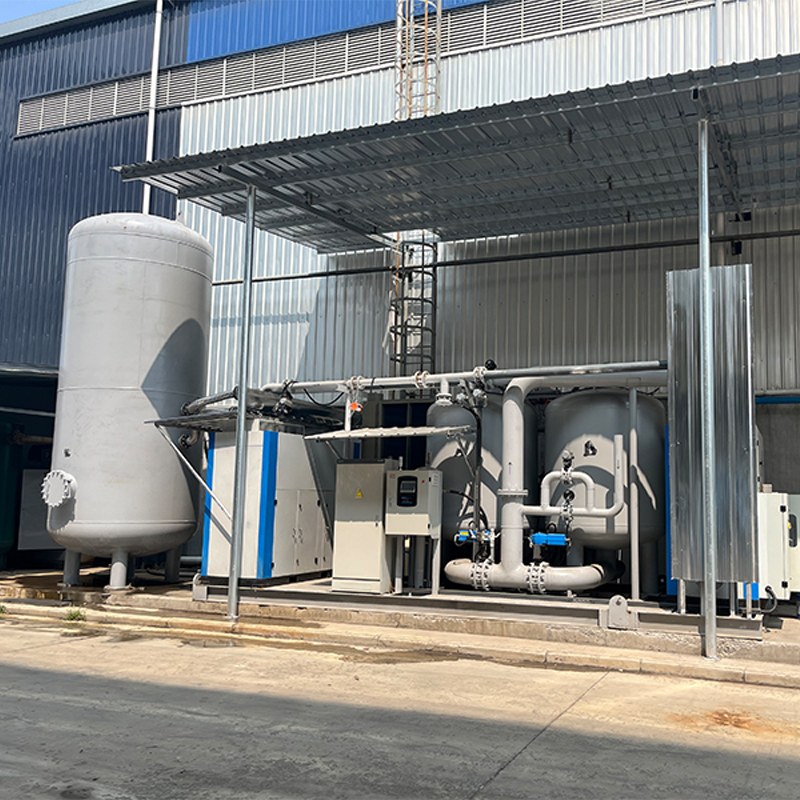-
WhatsApp / Mob : +86 156 5177 2521
-
이메일 : mrwin@cnbangwin.com
WhatsApp / Mob : +86 156 5177 2521
이메일 : mrwin@cnbangwin.com
Oxygen Plant in Aquaculture Industry: Working Principle, Benefits & Applications
Sep 30 , 2025An oxygen plant is a complete on-site oxygen generation solution for fish farms, shrimp ponds, or other aquaculture systems. A reliable supply of pure oxygen is needed to raise yields, improve stock health, and operate intensive, semi-intensive or integrated farming systems.
In the aquaculture industry, an oxygen plant refers to an industrial oxygen generator that produces pure oxygen from the ambient air. It is usually installed next to ponds, tanks, or hatcheries to supply on-demand, high-purity oxygen via pipelines or diffusers. The oxygen-enriched water provides the necessary dissolved oxygen (DO) levels for fish, shrimp, prawn, and aquatic plants to survive and thrive.
l Air Intake & Filtration: Fresh ambient air is drawn in through the air inlet and filtered to remove dust and moisture.
l Nitrogen Separation: Nitrogen and other gases are separated from the air, leaving an oxygen-rich gas product, using either PSA or cryogenic technology.
l Oxygen Delivery: The on-site generated high-purity oxygen is stored and then piped to the aquaculture system as required through diffusers, aeration cones, or flow meters.
l Continuous and on-site production of high-purity oxygen (90–99%).
l Low operating cost, thanks to energy-efficient PSA technology.
l Skid-mounted unit that can be installed easily on the ground.
l Automatic control and monitoring for a stable oxygen output.
l Robust design and components, low maintenance and a long service life.
|
Specification |
Typical Range/Options |
|
Oxygen Purity |
90% – 99% |
|
Production Capacity |
5 Nm³/h – 200 Nm³/h (customizable) |
|
Operating Pressure |
0.1 – 0.6 MPa |
|
Technology Options |
PSA (Pressure Swing Adsorption), Cryogenic |
|
Power Supply |
380V/50Hz or as required |
|
Applications |
Fish farms, shrimp ponds, RAS systems |
l Higher Fish Health. A stable DO level in water keeps fish stress-free and less prone to diseases.
l Higher Stock Density. High dissolved oxygen enables intensive farming and higher yields from each pond.
l Better Feed Conversion. Adequate oxygen levels improve feed absorption and metabolism.
l Reduced Mortality. Prevents sudden fish kills due to oxygen depletion, commonly caused by algal bloom or overstocking.
l Operational Savings. On-site oxygen production significantly reduces cost compared to cylinder oxygen supply.
l Fish Farms (Tilapia, Catfish, Salmon, Trout, etc.)
l Shrimp & Prawn Farms (Intensive or Semi-intensive Culture)
l Hatcheries (Maintaining Constant DO for Larvae and Fry)
l Recirculating Aquaculture Systems (RAS)
A1: Oxygen is required for the fish to respire and grow. Sufficient dissolved oxygen in the water also ensures good water quality and prevents stress or disease.
A2: Oxygen purities of 90–95% are adequate for most aquaculture systems.
A3: The PSA process uses zeolite molecular sieves to selectively adsorb nitrogen from the air. This results in continuous output of pure oxygen gas at the outlet.
A4: Yes, an on-site oxygen plant is cheaper to run than buying and renting oxygen cylinders. Cylinders involve transportation and rental fees as well as downtime when running out of oxygen.
Oxygen plants offer an effective and energy-efficient solution for aquaculture systems that need a continuous supply of high-purity oxygen. With an on-site oxygen plant, fish farmers can raise yields, improve fish health, increase stock density, and lower operating costs.
